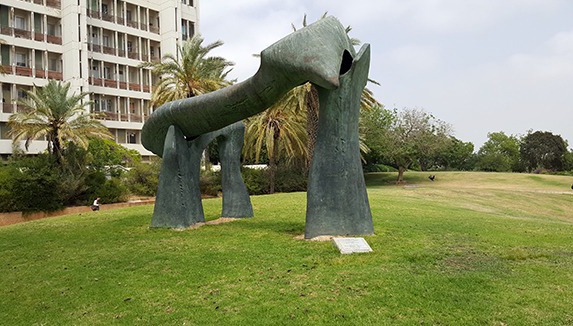Dolmenic Arch 1 | Eli Ilan
About the Work and the Creator / Etty Rosenberg
This monumental sculpture is composed of three hollow, simply organized, three-dimensional elements cast in unpolished bronze, which time and the climate have covered with a greenish-gray patina. These include a tall vertical element; an additional, lower vertical element that branches off in two directions; and a third, horizontal element that is supported by them, and which points towards the sky. The biomorphic forms and rounded, angular contours create a streamlined formal arrangement that resembles a window opening up onto the landscape; the space is not part of the sculptural mass, but rather envelops the sculpture and is framed by it.
Eli Ilan left his imprint upon the bronze surface by means of dense and expressive lines running in different directions - patterns whose fleshy texture resembles wood, deep slashes and imprints of fossils - as if a future archeologist were envisioning the frozen traces of the prehistoric era.

Symbol of Life and Death
Dolmenic Arch 1 may be viewed from various angles, which each change the perception of the sculpture and infuse its figurative quality with new life. From one angle, the sculpture resembles a dinosaur or another monumental animal that has long been extinct; from another viewpoint it resembles a splint supporting an enormous, fleshy, amputated leg; and from yet other angles it resembles a weave of biomorphic, geometric and abstract forms. This monumental sculptural assemblage exceeds the dimension of art and points to anthropological contexts, calling to mind ancient dolmens (alluded to by the title of the work) and mythological associations.
Dolmens are prehistoric monuments composed of megalithic stones, which usually marked burial sites and were part of rituals intended to overcome the certainty of death. The structure of a dolmen - two massive vertical stones overlaid by a horizontal stone - resembles that of a table; it is also reminiscent of one of the letters in the ancient Scandinavian alphabet that was associated with power. The gate-like form of dolmens marked a magical passage into other temporal and spatial dimensions, while megalithic monuments in general were perceived as mediating between earth and sky and as a visual symbol of life and death. These sublime stones commemorate the human beings who erected them1; their eternal dimension is hinted at by the name Dolmenic Arch - since triumphal arches were created to commemorate significant events or distinguished figures.
Animal-Like Qualities
The dinosaur image, which is perceived from another angle, symbolizes the animal-like qualities that continue to exist in man, and questions man's supremacy. The connection between the dolmen image and the animal image adds an irrational dimension to the reading of this sculpture; it may
thus be associated with myth and religious experience, which rely on images to intuitively transmit truth.3 Such associative connections appeal to the viewer through the use of the same technique employed by Surrealism, which attempted to provoke an experience of wonder. By means of unexpected coincidences and an appeal to primitive art, myth and "untrained" images, Surrealism attempted to achieve cultural wholeness and universal understanding.

Dolmenic Arch 1 reveals a connection to the Surrealism of the 1930s and 1940s, which attempted to use the metaphorical potential of myth to examine a reality at once atemporal and internal.5 Eli Ilan similarly attempts to distill the essence of life, while creating an equilibrium between hidden social characteristics and physical facts embodied in sculptural forms and volumes. The structure of human bones, basic natural forms, stones and trees have all inspired his work, which pulsates at the intersection of contrasts between strong and weak, passive and energetic, empty space and concrete forms. Dolmenic Arch 1 builds upon purified and distilled bronze forms and upon playful modulations and textural changes, which enable the viewer to grasp the sculpture's monumental quality regardless of its size.
In the spirit of Itzhak Danziger's artwork, Dolmenic Arch 1 reflects an understanding of the artist as a mediator between different cultural systems; the very act of mediation, according to this understanding, enables one to find meaning and comfort in human existence.6 Images of animals also occupy a central place in Itzhak Danziger's work, where their attempt to strive beyond the symbolic acquires a human quality. Animals bear the imprint of the landscape, while simultaneously leaving their own imprint upon it; their reciprocal relations with their environment create an entire ecological system.
Eli Ilan's sculpture awakens the dinosaurs slumbering within an assemblage of archetypal images - a memory of the collective past that is related to a shared history and myths; it ties the experience of the creative artist to a more general cultural experience, while transforming a concrete landscape into a metaphysical experience.
| Artist: | |
| Eli Ilan | |
| Name: | |
| Dolmenic Arch 1, 1981 | |
| Location: | |
| In front of the ANU Museum | |
| Donated by Sir Leslie and Lady Porter, England |





